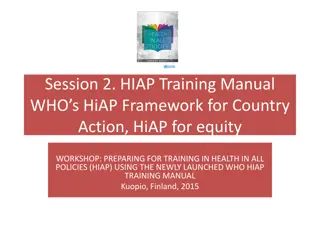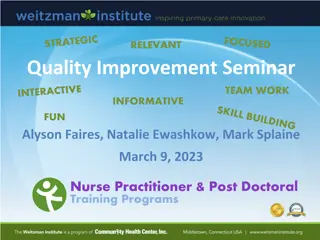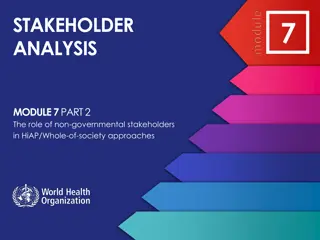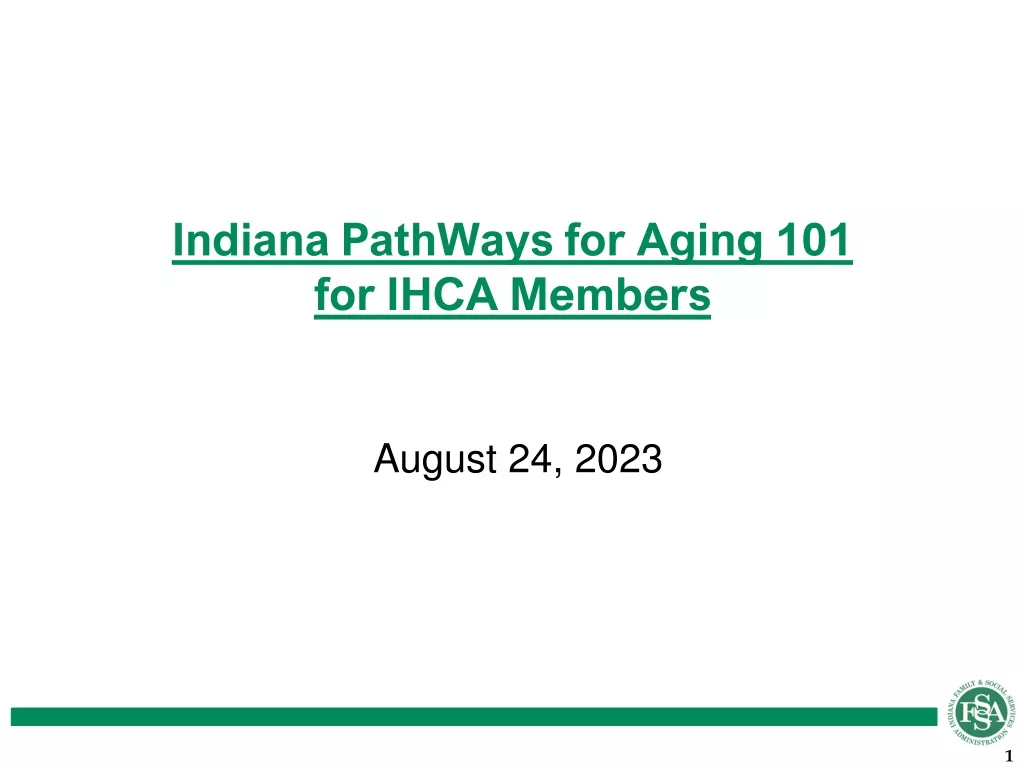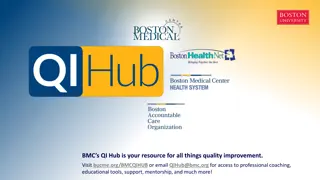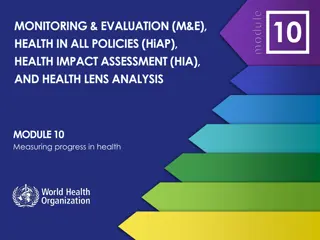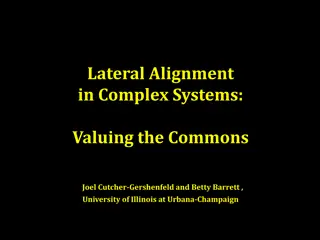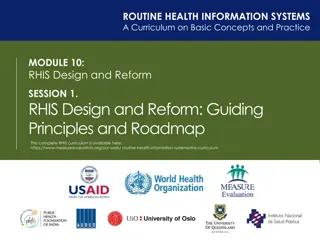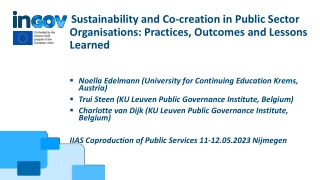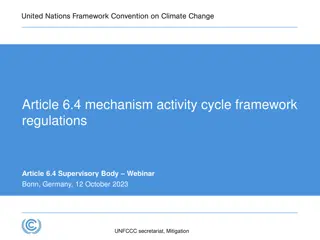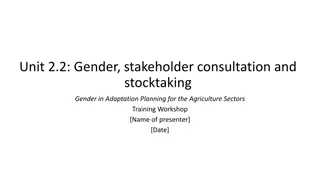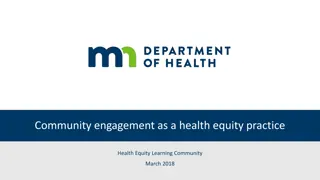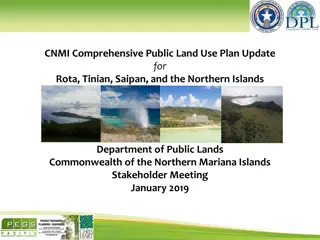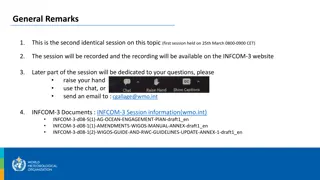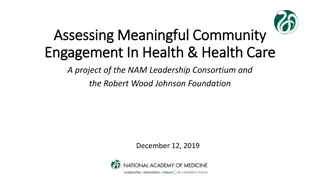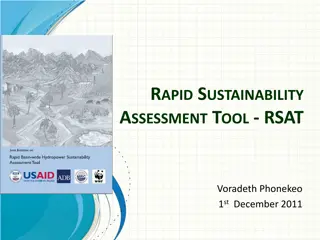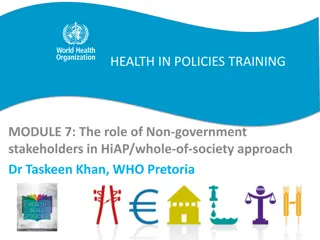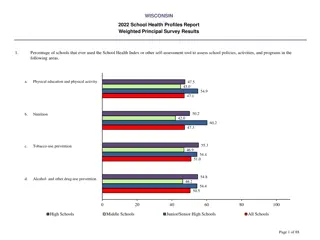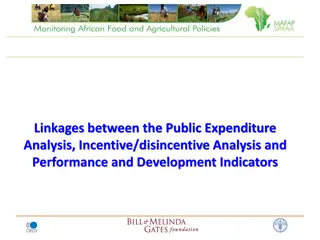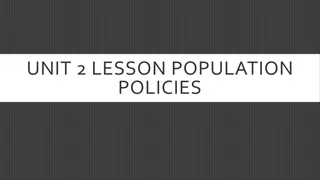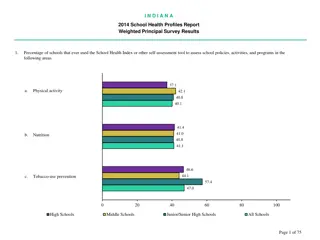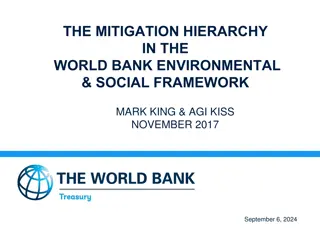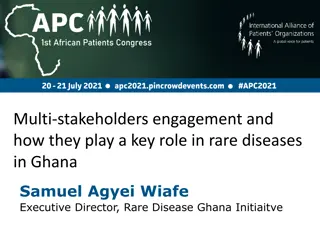Importance of Stakeholder Engagement in Health Policies
Understanding the role of non-governmental stakeholders in Health in All Policies (HiAP) and whole-of-society approaches is crucial for effective policy implementation. This module discusses the definition of stakeholders, benefits, challenges, principles for consultation, and strategies to counteract opposition. It also distinguishes between whole-of-government and whole-of-society approaches, emphasizing the significance of stakeholder consultation in enhancing accountability, governance, collaboration, and sustainability of interventions.
Download Presentation

Please find below an Image/Link to download the presentation.
The content on the website is provided AS IS for your information and personal use only. It may not be sold, licensed, or shared on other websites without obtaining consent from the author. Download presentation by click this link. If you encounter any issues during the download, it is possible that the publisher has removed the file from their server.
E N D
Presentation Transcript
STAKEHOLDER ENGAGEMENT 7 MODULE 7 PART 1 The role of non-governmental stakeholders in HiAP/Whole-of-society approaches
LEARNING OBJECTIVES 7 Define a stakeholder and provide examples 1 Explain the benefits and challenges of non- government stakeholder engagement 2 List principles for effective and accountable stakeholder consultation 3 Recognize strategies used by actors to counteract efforts to improve health and inequity 4
WHOLE-OF-GOVERNMENT VS WHOLE-OF-SOCIETY APPROACHES 7 Intersectoral action refers to the coordinated efforts of two or more sectors within government to improve health outcomes. This can include working across different levels of government such as district, provincial and national jurisdictions. The term intergovernmental is sometimes used to refer to these horizontal and vertical linkages between levels of government within a country. Whole-of-government, joined-up government and healthy public policies are similar terms used in the HiAP literature. A whole-of-society approach, in contrast, refers to coordinated efforts to improve health by multiple stakeholders within and outside government that may also be from several sectors.
DEFINING A STAKEHOLDER 7 A primary stakeholder is one who, without continuing participation, the policy or issue could not succeed or be addressed. For example, schools might be a primary stakeholder when dealing with the issue of healthy foods for children. A secondary stakeholder is one who has some influence or is affected by the policy or issue. However, their engagement is not essential to address the issue or to take policy action. For example, car manufacturers might be a secondary stakeholder when addressing road safety and drink driving.
WHY IS STAKEHOLDER CONSULTATION IMPORTANT? 7 Increases accountability and is an indicator of good governance. Practical policy benefits: Assessing support and opposition to a policy Giving government activities visibility and legitimacy Empowering the marginalized Increasing collaboration and the more efficient use of resources Ensuring the sustainability of interventions.
OTHER BENEFITS OF STAKEHOLDER CONSULTATION 7 Can help accumulate evidence and public support for radical measures to improve population health and inequity. Harness windows of opportunity as a collective. Best practice demonstrates desire to engage in meaningful two-way/multi-directional communication, and recognizes the important contribution stakeholders at all levels can make to future policy changes.
THE TRIANGLE THAT MOVES MOUNTAINS 7 Relevant knowledge Social Political leadership movement Source: based on Wasi P (2000) Triangle that moves the mountain and health systems reform movement in Thailand. Human Resources for Health Development Journal, Vol. 4, No. 2, pp. 106 110 (http://www.who. int/hrh/en/HRDJ_4_2_06.pdf).
CHALLENGES OF STAKEHOLDER ENGAGEMENT 7 SOME OF THE CHALLENGES OR RISKS OF STAKEHOLDER ENGAGEMENT CAN INCLUDE: Prolonging policy-making Increasing costs of intervention Polarizing interest groups Creating unmanageable expectations
FINDING THE BALANCE IN STAKEHOLDER ENGAGEMENT 7 Legitimacy Speed Quality of stakeholder participation Source: Vallejo N and Hauselmann P (2004) Governance and Multi-stakeholder Processes. International Institute for Sustainable Development, p. 6.
7 PRINCIPLES OF STAKEHOLDER ENGAGEMENT Empowerment Accountability Transparency Cost-effectiveness Resources
GOVERNMENT INVOLVEMENT WITH OTHER ACTORS: CIVIL SOCIETY 7 Civil society (whole-of-society approach to HiAP) can encompass many actors including: Non-government organizations Faith-based groups Labour unions Philanthropic foundations Professional associations Cooperatives and research institutions. These actors are not-for-profit.
EXAMPLE: CONTRIBUTION OF CIVIL SOCIETY TO HiAP 7 FISH FARMING PROJECT IN SOUTH IMENTI CONSTITUENCY IN MERU COUNTY, KENYA
GOVERNMENT INVOLVEMENT WITH OTHER ACTORS: PRIVATE SECTOR 7 Unlike civil society, the characteristic that the private sector ultimately shares is the pursuit of profit. There has always been critical public health analysis of the power of the private sector especially in the field of tobacco and attention has turned to other areas in recent years: E.g. work on unhealthy commodities (commercial determinants of health). This suggests scepticism and caution.
GOVERNMENT INVOLVEMENT WITH OTHER ACTORS 7 : THE PRIVATE SECTOR AND THE ECONOMIC DETERMINANTS AND COMMERCIAL/CORPORATE INTERESTS AND INFLUENCE Economic/corporate interests have an important role in shaping population health and health equity e.g. through trade and globalization. Private sector influence has risen exponentially with an increase in large private foundations and public-private partnerships as a result of economic globalization and trade liberalization.
GOVERNMENT INVOLVEMENT WITH OTHER ACTORS (CONT.) 7 : THE PRIVATE SECTOR AND THE ECONOMIC DETERMINANTS AND COMMERCIAL/CORPORATE INTERESTS AND INFLUENCE Fit-for-purpose regulatory regimes are needed to constrain negative corporate influences on health and encourage ethical business practices beneficial for population health. Encourage positive economic determinants of health.
COMMERCIAL DETERMINANTS OF HEALTH 7 Commercial determinants of health: strategies and approaches used by the private sector to promote products and choices that are detrimental to health. Kickbusch I, Allen L & Franz C (2016). The commercial determinants of health. The Lancet Global Health; 4(12), PE895-E896. Transnational food companies powerfully shape the supply, demand, and consumption of food and beverage products increasing consumption of ultra-processed foods and sugary beverages linked to rising levels of obesity.
COMMERCIAL DETERMINANTS OF HEALTH (CONT.) 7 Global food industry also has a significant influence on policy and regulation that aims to improve nutrition and diet-related health Increasingly engages in collaborative initiatives with government that have obesity prevention objectives e.g. Australia s Health Star food labelling system.
THE PUBLIC-PRIVATE MIX IN THE POLICY DIALOGUE 7 Public interest vs Private interest often a critical barrier that has to be tackled in developing policy change focusing on the public/private mix. Government needs to manage the less desirable features that the private sector may bring to policy development. Interactions between government(s) and the private sector need to be guided by public interest and transparency.
PUBLIC-PRIVATE PARTNERSHIPS (PPPs) 7 A PPP IS DEFINED BY REICH1 AS: The collaborations should involve at least one public organization and one private profit-making organization. The public organization could include national government bodies and international agencies such as the WHO, World Bank or a United Nations agency. The private sector normally would extend to any type of profit-making corporation. 1 2 The partners will have certain common goals for a particular health problem. 3 The different partners will divide the workload and mutually receive benefits. 1Reich M (ed.) (2002) Public-Private Partnerships for Public Health, Harvard Series on Population and International Health. Cambridge, MA, Harvard University Press.
EXAMPLE: PRIVATE SECTOR INVOLVEMENT IN HiAP - PUBLIC-PRIVATE PARTNERSHIP 7 SUCCESSFUL SODIUM REGULATION IN SOUTH AFRICA
CONSIDERATION OF CORPORATE INTERESTS IN THE POLICY DIALOGUE 7 CORPORATE INTERESTS CAN PERMEATE THE POLICY DIALOGUE AND UNDERMINE GOVERNMENT ACTIONS BY: Casting doubt on scientific evidence and misleading the public Promoting ineffective policy solutions Lobbying Participating as an actor in the policy arena
CONSIDERATION OF CORPORATE INTERESTS IN THE POLICY DIALOGUE 7 CORPORATE INTERESTS CAN PERMEATE THE POLICY DIALOGUE AND UNDERMINE GOVERNMENT ACTIONS BY: Using litigation to challenge policy decisions Creating alliances with other business sectors Moving to countries with least resistance
INTERACTIONS WITH THE PRIVATE SECTOR 7 SUPPORT THE CREATION OF POSITIVE CONDITIONS FOR HEALTH IN THE PRIVATE SECTOR: Produce balanced sectoral reports that consider actions to promote a responsible private sector Conduct and provide evidence and tools for health equity impact assessments of trade, investment, fiscal and monetary policies Define models for ethical investment that increase health equity Mobilise resources and capacities for health equity impact assessments of trade/fiscal/economic policies through building- up a community of practice across academia and NGOs Improve policy coherence across all sectors.
CATALYZING MULTISECTORAL ACTION ON NCDs: WHOLE-OF-SOCIETY APPROACH 7 Engaging beyond the health sector: developing NCD responses will require action across all government departments, as well as the engagement of civil society and the private sector. Bridging the governance gap: strong governance and regulatory frameworks are a prerequisite for: Protecting the development of NCD policies from undue influence by any real, perceived or potential conflict of interest, including between the tobacco industry and public health; and Mobilizing adequate and sustained resources to implement NCD responses from public resources, private business and finance, and international development cooperation, including voluntary innovative financing mechanisms.
End of Module 7 Part 1 Please continue to Module 7 Part 2


